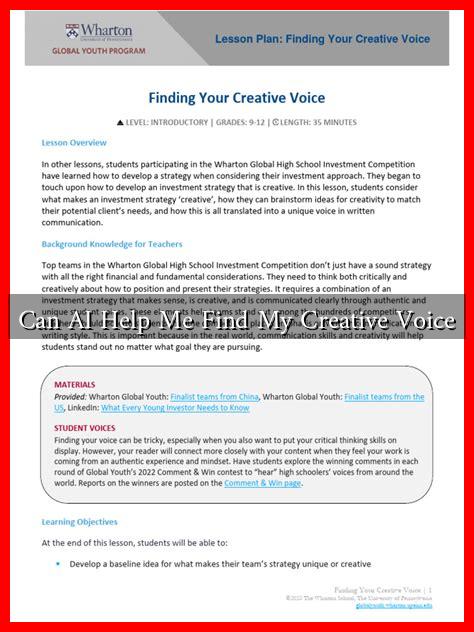-
Table of Contents
Can AI Help Me Find My Creative Voice?
In an age where technology permeates every aspect of our lives, the intersection of artificial intelligence (AI) and creativity is becoming increasingly relevant. Many artists, writers, musicians, and creators are exploring how AI can assist them in discovering and refining their unique creative voices. But can AI truly help in this deeply personal journey? This article delves into the ways AI can support creative expression, the tools available, and the implications of using AI in the creative process.
The Role of AI in Creativity
AI has made significant strides in various fields, including art, music, and writing. By analyzing vast amounts of data, AI can identify patterns, generate ideas, and even create original works. Here are some ways AI can assist in the creative process:
- Idea Generation: AI can help brainstorm ideas by analyzing existing works and suggesting new concepts based on trends and themes.
- Style Imitation: Tools like DeepArt and Runway ML allow users to apply different artistic styles to their work, helping them explore various aesthetics.
- Feedback and Critique: AI-driven platforms can provide constructive feedback on creative works, helping artists refine their skills.
- Collaboration: AI can act as a creative partner, generating content that artists can build upon, thus fostering collaboration between human and machine.
AI Tools for Creative Exploration
Several AI tools are designed specifically to aid creators in their artistic journeys. Here are a few notable examples:
- OpenAI’s ChatGPT: This language model can assist writers by generating text, suggesting plot ideas, or even helping with dialogue. Writers can use it to overcome writer’s block or explore new narrative directions.
- Amper Music: This AI music composition tool allows musicians to create original music tracks by selecting mood, style, and instrumentation, making it easier to experiment with different sounds.
- DALL-E: Another OpenAI project, DALL-E generates images from textual descriptions, enabling artists to visualize concepts that may be difficult to articulate.
- Artbreeder: This platform allows users to blend images and create new artworks by adjusting parameters, fostering a collaborative environment for visual artists.
Case Studies: Success Stories of AI in Creative Fields
Several artists and creators have successfully integrated AI into their work, showcasing the potential of this technology in finding one’s creative voice:
- Refik Anadol: A media artist and director, Anadol uses AI to create stunning visual installations that explore the intersection of art and technology. His work demonstrates how AI can enhance artistic expression and push creative boundaries.
- Holly Herndon: A composer and musician, Herndon incorporates AI into her music, using it as a tool for collaboration. Her project “Spawn” features an AI that learns from her voice, creating a unique blend of human and machine-generated sound.
- Janelle Monáe: The singer and actress has experimented with AI-generated visuals in her music videos, showcasing how technology can complement and enhance artistic storytelling.
The Ethical Considerations of AI in Creativity
While AI offers exciting possibilities for creative exploration, it also raises ethical questions. Issues such as copyright, originality, and the potential for homogenization in art must be considered. As AI-generated content becomes more prevalent, the distinction between human and machine creativity may blur, leading to debates about authorship and authenticity.
Conclusion: Embracing AI as a Creative Ally
AI has the potential to be a powerful ally in the quest for finding one’s creative voice. By providing tools for idea generation, style exploration, and collaboration, AI can help artists and creators push their boundaries and discover new avenues of expression. However, it is essential to approach this technology with a critical eye, considering the ethical implications and ensuring that the human element of creativity remains at the forefront.
In summary, AI can indeed help you find your creative voice by:
- Offering innovative tools for idea generation and exploration.
- Facilitating collaboration between human creativity and machine intelligence.
- Providing constructive feedback to refine artistic skills.
As you embark on your creative journey, consider how AI can complement your unique voice rather than replace it. Embrace the possibilities, and let technology enhance your artistic expression.
For more insights on the intersection of AI and creativity, visit Creative Bloq.

